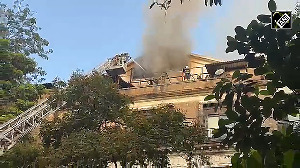When Tata Group chairman Ratan Tata announced the sweet-spot pricing strategy for a Rs 100,000 car, it made international headlines. But now quietly and without much fuss, another story has unfolded from Tata's commercial vehicle stable. Already, the Ace - launched in May 2005 - which is the base model in commercial vehicles segment of Tata Motors, surpassed the company's target of 30,000 units in its first year of operations.
The raison d'être for the four-wheeled Ace? Upgrade three-wheeler goods carrier buyers. But that's just one way of looking at it. the strategist explores how the Ace fits in with the overall strategy of Tata Motors and how the company executed the launch.
Commercial sense
Ever since 2000 - when Tata Motors made a hefty Rs 500 crore (Rs 5 billion) loss in its worst financial performance - the company has been looking at ways to overcome cyclical ups and downs.
The company chalked out a two-pronged strategy. The first was the classical route of trying to balance sales in different markets. Through an overseas push, Tata Motors felt this could be done. If there was a downturn in one market, an upturn in another could help it tide over fluctuating market situations. The acquisition of Daewoo's commercial vehicles business in March 2004 was a step in that direction.
The second part of the strategy was to add to its portfolio, products that would largely be immune to industry fluctuations. One way out: make vehicles that were smaller.
Buyers of small and light commercial vehicles are largely individuals. The 207 DI (small commercial vehicle two-tonner) launched in August 2002, which had a Tata Mobile chassis and the successful Tata 407's engine, was one such instance.
The Ace was another part in this product strategy. However, industry analysts say that developing the one-tonne Ace was a tougher task in many ways than the 207 DI.
The challenges were both internal and external. One was to have the entire management team on the same wavelength on various operational and developmental issues.
For instance, at the time of the launch of Ace, Tata executives spoke about several occasions when the top management of Tata Motors had turned down requests for additional budgets.
Right costing was another challenge. The vehicle had to be built to a pre-determined price band, that too at a certain quality standard. If potential buyers were individuals who would otherwise opt for a three-wheeler, they had to be given a vehicle that would look and perform better. In this quest, the vehicle cabin incorporated car-like features to stand out in a crowd of rudimentary three wheelers.
"Apart from the hygiene quality we also looked at the aspects of delight and value enhancers," says Shyam Mani, vice president, sales and marketing, commercial vehicles, Tata Motors.
Partly to keep costs under control, the company also banked on outsourcing. Today, a significant 82 per cent of the Tata Ace is outsourced. Even some of the design elements were focused on costs.
For instance, the design for the headlamps of the Ace are borrowed from the multi-utility vehicle, Tata Sumo. The idea was that where there was no need to reinvent the wheel, they should share best practices and tap synergies.
It also paid attention to safety features. For instance, the rearview mirror was mounted on the windscreen glass instead of the roof of the vehicle.
The logic: the windscreen of a vehicle has the lowest vibration, so the rearview for the driver will be perfect. It is trying to add value for customers in other ways too. The company recently introduced a range of Ace accessories like a vehicle protection system, music systems and even Ganesha idols.
Customer gains
The company also did a market segmentation analysis to understand potential customers better. There were primarily two sets of customers: entry-cost sensitive customers and others who valued return-on-investment.
The company decided to focus on the ROI-sensitive customer who would be willing to pay a slightly higher price, but would require lower operating costs.
Tata Motors also had to address a key concern of commercial vehicle buyers - lead (time taken to travel a distance) and load (weight it could take). Hence, the Ace was built to achieve top speeds of 64 kmph compared to 50-56 kmph in the case of three-wheelers.
From the customers point of view, it could mean more trips on any given day. In terms of load bearing capacity, the cargo bed of the Ace was bigger at 2,200X1,500 mm, compared to an average of 1,950X1,450 mm of other three-wheelers.
There were other benefits, too. In running costs, the company claims that Ace requires an oil change only after every 9,000 kilometres of driving, compared to 2,500-5,000 kilometres in the case of threewheelers. Savings: Rs 1,000-Rs 1,500.
Reach for the stars
Before the launch of Ace, Tata Motors had to pay attention to one important aspect. "We could not go into the market with the mindset of selling a medium and heavy commercial vehicle," says Tata Motors' Mani.
For instance, medium and heavy commercial vehicles typically cover hundreds of kilometres at a stretch - even the 207 DI travels an average distance of more than 200 kilometres a day.
Not so for the Ace. The operators of the vehicle travel for a shorter distance as it is primarily used for last mile transport between the outskirts of a city to the centre (60-100 kilometres). One fallout: it would be too much to expect owners to drive a longer distance to get to an after-sales outlet.
So, while focusing on maximum reach it tried to benchmark itself broadly with motorcycles. Typically, motorcycle manufacturers have a sales or service outlet every 10-20 kilometres. That scale of reach was not required for selling the Ace.
Nevertheless, Tata Motors had to augment distribution. To increase the number of service outlets, the company trained automobile garages and branded them Tata-certified service points.
At present, the company claims to have a sales or authorised service station at every 50-70 kilometres in the states where the Ace is sold.
Now, Tata Motors was ready for the acid test in choosing its entry and market strategy. One choice was to follow a tried and successful route taken by the 207 DI during launch. The 207 DI made its foray in a smaller market such as the north-east.
At that time, this region was out of market leader, Mahindra & Mahindra's radar and through this deliberate strategy, Tata Motors managed to create a market for pick-ups in that region.
But this time, Tata Motors took the battle straight to the enemy camp. With an aggressive pricing strategy, it launched the Ace in Tamil Nadu, Kerala, Karnataka, Andhra Pradesh and Maharashtra - 70 per cent of three- wheeler sales happen in these five states.
At a value price point of Rs 220,000, the Ace was targeted to attract buyers who would otherwise buy three-wheelers at price points from Rs 120,000-Rs 190,000.
Clearly, if the price and product were in place, positioning could not afford to be behind. But the advertising was careful that it did not hype-up the looks of the Ace. "There was a danger of being seen as a delicate vehicle that could not carry a heavy load," says another Tata executive. Hence, the company positioned the Ace as a Tata truck in a mini-size.
The Ace effect
In the future, to broaden its customer base, the Ace will also position itself now as a passenger vehicle. "The Ace will soon ferry passengers from the outskirts of a village to small towns," declares Mani.
Carrying passengers is un-chartered territory for the Ace. And that's also a strategy that has its inherent dangers. While transporting passengers, the Ace might also cross the lane of Tata's own multi-utility vehicle, the Sumo, which is used as a vehicle by tour operators.
Then, the advantage that the Ace has over three-wheelers (it can travel on highways and expressways because of the stability offered by four wheels) could hurt the prospect of pick-ups including Tata's own 207 DI.
But Tata executives argue that for applications like transporting milk or vegetables over a distance of 200 kilometres, the 207 DI cannot be replaced. That's because its top speed is 100-120 kmph - roughly twice that of the Ace.
To be sure, three-wheelers are far from being dislodged on Indian roads. According to SIAM estimates, during the period April 2005-March 06, the three-wheeler goods carrier segment grew by 8.05 per cent, when the entire automobile segment in India grew at 12.82 per cent.
But Tata Motors has come a long way. From manufacturing big trucks, which the company set up decades ago in collaboration with Mercedes Benz, to the one-tonne Ace now. Will three-wheelers be the next stop?







 © 2025
© 2025